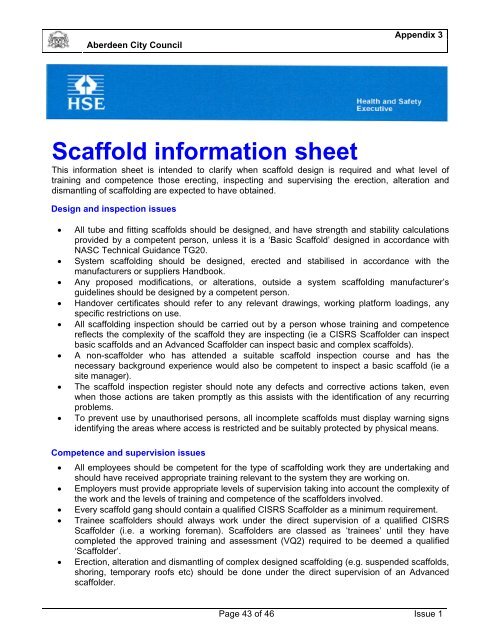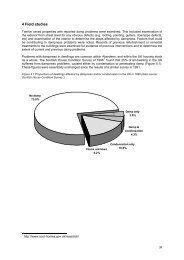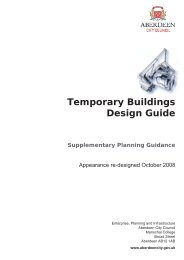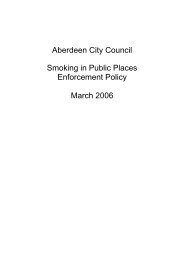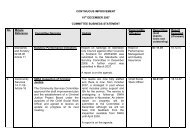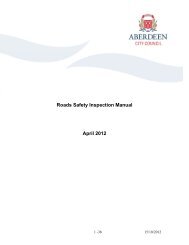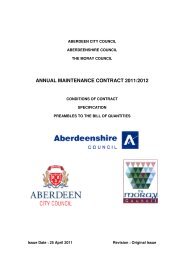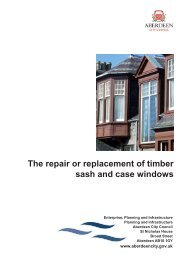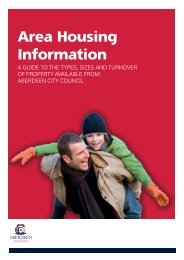Scaffold Protocol - Aberdeen City Council
Scaffold Protocol - Aberdeen City Council
Scaffold Protocol - Aberdeen City Council
- No tags were found...
You also want an ePaper? Increase the reach of your titles
YUMPU automatically turns print PDFs into web optimized ePapers that Google loves.
<strong>Aberdeen</strong> <strong>City</strong> <strong>Council</strong>Appendix 3<strong>Scaffold</strong> information sheetThis information sheet is intended to clarify when scaffold design is required and what level oftraining and competence those erecting, inspecting and supervising the erection, alteration anddismantling of scaffolding are expected to have obtained.Design and inspection issues• All tube and fitting scaffolds should be designed, and have strength and stability calculationsprovided by a competent person, unless it is a ‘Basic <strong>Scaffold</strong>’ designed in accordance withNASC Technical Guidance TG20.• System scaffolding should be designed, erected and stabilised in accordance with themanufacturers or suppliers Handbook.• Any proposed modifications, or alterations, outside a system scaffolding manufacturer’sguidelines should be designed by a competent person.• Handover certificates should refer to any relevant drawings, working platform loadings, anyspecific restrictions on use.• All scaffolding inspection should be carried out by a person whose training and competencereflects the complexity of the scaffold they are inspecting (ie a CISRS <strong>Scaffold</strong>er can inspectbasic scaffolds and an Advanced <strong>Scaffold</strong>er can inspect basic and complex scaffolds).• A non-scaffolder who has attended a suitable scaffold inspection course and has thenecessary background experience would also be competent to inspect a basic scaffold (ie asite manager).• The scaffold inspection register should note any defects and corrective actions taken, evenwhen those actions are taken promptly as this assists with the identification of any recurringproblems.• To prevent use by unauthorised persons, all incomplete scaffolds must display warning signsidentifying the areas where access is restricted and be suitably protected by physical means.Competence and supervision issues• All employees should be competent for the type of scaffolding work they are undertaking andshould have received appropriate training relevant to the system they are working on.• Employers must provide appropriate levels of supervision taking into account the complexity ofthe work and the levels of training and competence of the scaffolders involved.• Every scaffold gang should contain a qualified CISRS <strong>Scaffold</strong>er as a minimum requirement.• Trainee scaffolders should always work under the direct supervision of a qualified CISRS<strong>Scaffold</strong>er (i.e. a working foreman). <strong>Scaffold</strong>ers are classed as ‘trainees’ until they havecompleted the approved training and assessment (VQ2) required to be deemed a qualified‘<strong>Scaffold</strong>er’.• Erection, alteration and dismantling of complex designed scaffolding (e.g. suspended scaffolds,shoring, temporary roofs etc) should be done under the direct supervision of an Advancedscaffolder.Page 43 of 46 Issue 1


